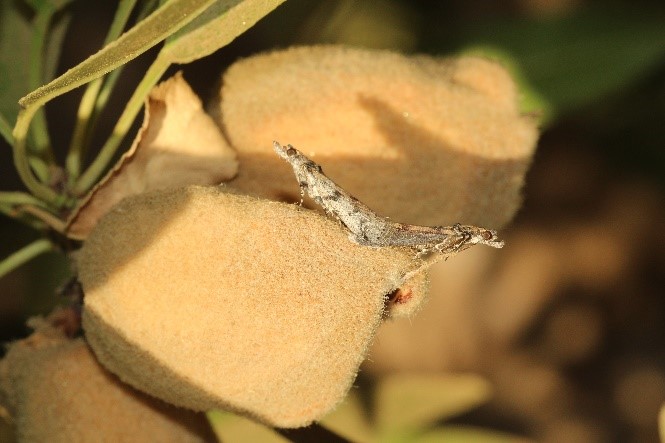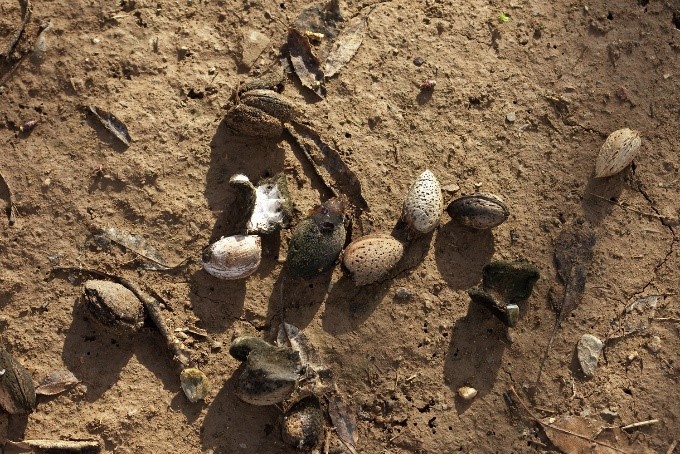 Navel orangeworm moths can lead to season-long challenges if gone unaddressed using IPM practices, including mating disruption. (Photo credit: David Haviland/UCCE)
Navel orangeworm moths can lead to season-long challenges if gone unaddressed using IPM practices, including mating disruption. (Photo credit: David Haviland/UCCE)
(April 10, 2020) - Navel orangeworm (NOW) is the most serious insect pest for California almonds as it causes both direct damage to the nuts as well as abetting growth of a serious food contaminant. Both are costly to growers and handlers.
For this reason, careful, year-long NOW management is crucial to a healthy almond crop, especially during this season when NOW’s first flight is taking place and the second is right around the corner.
NOW moths fly and lay eggs three to four times per year. With each generation, their numbers increase exponentially. They can be especially troublesome during their second flight, which coincides with hullsplit and when almonds are particularly vulnerable. Hatching larvae wreak havoc by worming into kernels and opening the door for fungal contamination to move in, including Aspergillus mold, which can produce aflatoxins (at least two forms of aflatoxin are found in almonds). From there, tiny amounts of aflatoxin can easily exceed federal and international limits, so to avoid rejections of almond shipments handlers incur extra costs to sort and test lots that come in with high damage.
“Growers should not underestimate the impact NOW can have on profitability and almonds’ image to buyers, food safety regulators and consumers. Thus, the importance of a year-round integrated pest management approach to monitoring for and preventing NOW,” said Gabriele Ludwig, director, Sustainability and Environmental Affairs, Almond Board of California. “I have seen ‘do not eat’ advisories in the German media for food items with too-frequent aflatoxin detection.”
NOW management, therefore, relies on vigilance and proactive steps at key intervals throughout the year, said David Haviland, entomologist and farm advisor for the University of California Cooperative Extension in Kern County.
“Effective management relies on a grower’s ability to integrate multiple techniques into their year-round practices, including the cultural practices of thorough winter sanitation and early harvest, and incorporating mating disruption, as well as pest control sprays, into the plan” said Haviland.
 Mummy nuts can harbor overwintering navel orangeworm, opening up a sea of challenges for next year’s crop, if not destroyed.
Mummy nuts can harbor overwintering navel orangeworm, opening up a sea of challenges for next year’s crop, if not destroyed.
Sanitation involves shaking unharvested “mummy nuts” from trees by going through the orchard with the shaker, hand poling and then mowing or disking through the orchard to destroy those nuts before early March. This practice eliminates overwintering NOW and removes egg-laying sites from NOW for the second flight, allowing growers to increase their chances to outpace this harmful pest.
In addition to cultural practices, two key strategies for NOW control include mating disruption and properly timed insect sprays.
Mating disruption (MD) involves hanging pheromone-emitting dispensers at strategic spots throughout the orchard. These emitters confuse male moths, making it hard for them to find females and mate. For these dispensers to work efficiently, they need to be placed on limbs halfway up the tree in late March and early April, following manufacturers’ guidance. This allows them to disrupt mating for three to four flights during the year.
This technique — despite upfront cost — pays off, especially in orchards with a history of high NOW pressure. According to research by Haviland and fellow IPM farm advisor Jhalendra Rijal adding MD to an existing management program cuts NOW damage in half, with increased grower returns averaging $123 per acre, after accounting for the costs to implement MD. In other words, growers made money by implementing MD.
In orchards with high NOW levels, even with the use of MD, hullsplit sprays may be necessary. Growers need to work with their PCAs to determine if hullsplit sprays are needed and to nail down the appropriate timing and number of sprays to reduce crop damage due to NOW.
For effective hullsplit sprays, growers should keep four key factors in mind as they prepare to make spray applications: timing, calibration, speed and spray volume.
- Timing: Timing should coincide with the beginning of hullsplit and with the beginning of NOW’s second flight. It’s essential that the first spray (if multiple are needed) is completed no later than 1% hull split.
- The start of egg-laying can be predicted by establishing an egg trap biofix in April or May, and then calculating 1050 degree-days. Pheromone traps in June and early July can also help determine when the second flight starts. Details on how to use degree-day models can be found within UC IPM’s Pest Management Guidelines for Almonds.
- To predict the onset of hullsplit, growers should reference the Almond Hull-Split Prediction Model, created by Professor Ted DeJong from the Department of Plant Sciences at UC Davis.
- Calibration: It’s important that sprayers are set up properly so that each application reaches the top level of the trees while also minimizing spray drift.
- Speed: Growers and applicators need to go the proper speed – a recommended two miles per hour – to optimize coverage in the orchard.
- Spray Volume: Decades of research shows that using 200 gallons per acre, with the rig traveling at the proper speed, will maximize effectiveness of the application.
To learn more about NOW control using effective IPM, visit the UC IPM webpage dedicated to NOW damage, management and more.